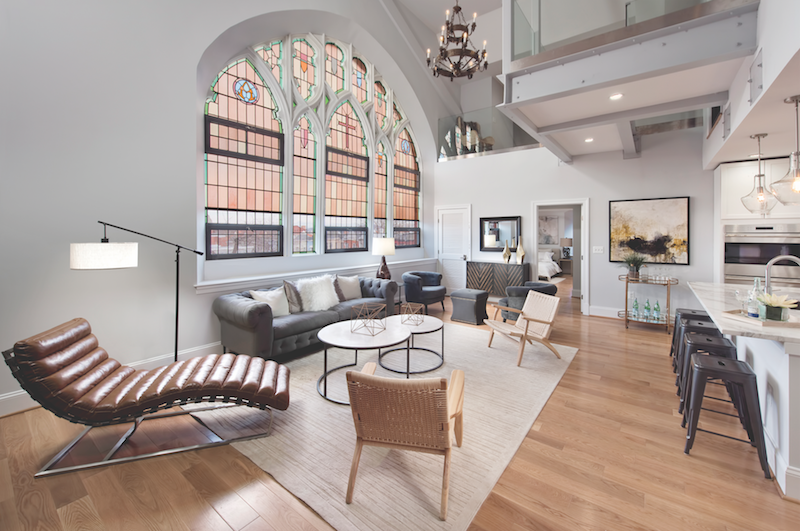One of the curious things about the Nation’s Capital is that, unlike many older U. S. cities, Washington, D. C., never had any industry to speak of—unless you count the manufacture of hot air as an industry. In the District of Columbia, you don’t see those wonderful 19th-century Italianate factories that dot the cityscapes of Boston, New York, Baltimore, Chicago—strong-boned, high-ceilinged brick edifices that convert into magnificent loft apartments, condominiums, and mixed-use centers.
What Washington does have aplenty is churches and other “religious locations” —by one count, 857, or one for every 758 residents. Until recently, the Way of the Cross Church, a Gothic Revival structure that dates to 1898, was among them. Today, it is the Sanctuary, a handsome 30-unit condominium complex at 819 D St., NE.
The Sanctuary may represent the vanguard of a new trend in Washington: the conversion of some of the city’s older churches—many of them located in emerging or already desirable neighborhoods—to sorely needed residential use.
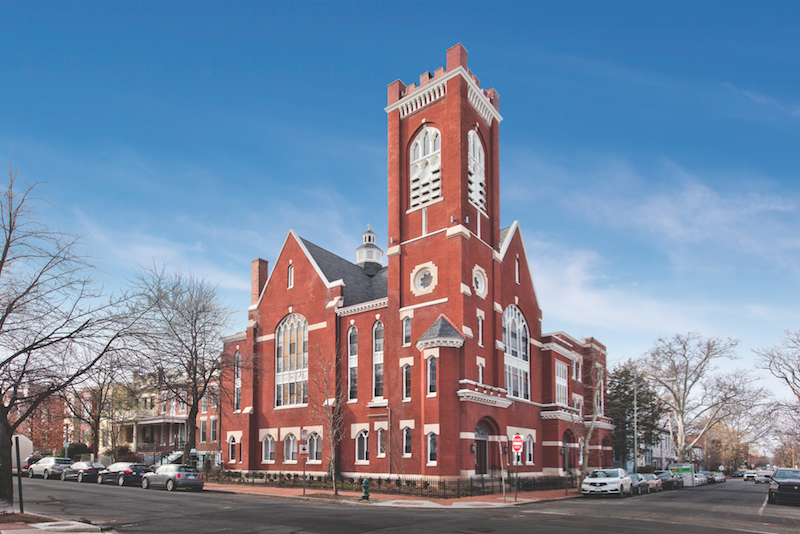 Exterior of the Sanctuary, at 816 D St., NE, Washington, D. C. The original Ninth Street Congregational Church dates from 1898. A three-story classroom annex built in 1916 now includes townhouses.
Exterior of the Sanctuary, at 816 D St., NE, Washington, D. C. The original Ninth Street Congregational Church dates from 1898. A three-story classroom annex built in 1916 now includes townhouses.
The church and its adjacent annex came on the market in 2014. The congregation had been migrating to the Maryland suburbs, and the sale of the church helped them finance construction of a larger building in Capitol Heights, Md. After some ownership changes, the quarter-acre property came under control of The Rubin Group, in partnership with real estate finance firm Regua. Andrew T. Rubin, Principal in the family-owned firm, brought in Bill Bonstra, FAIA, LEED AP, Founder of Washington design firm Bonstra | Haresign Architects, to lead the project.
In the course of the next two years, Rubin and Bonstra would learn more than they ever wanted to know about stained glass.
GETTING ALL THE NECESSARY APPROVALS
The first item on Rubin and Bonstra’s checklist was to obtain special zoning relief to change the building’s use to residential. Parking was the neighbors’ number one hot button. For years, local residents had been inconvenienced by church members taking up street parking on Sundays and weeknights. After meeting numerous times with the local Advisory Neighborhood Commission and other civic groups, Rubin and Bonstra were able to convince the locals that the parking problem would mostly go away once the church was shifted to residential use—especially with local bus, train, and new H Street trolley service in the neighborhood.
The more vexing problem had to do with the historic nature of the neighborhood. Although the church was not a designated landmark, because it was in the Capitol Hill Historic District and of a certain age, it was deemed a “’contributing building” under the District’s historic preservation guidelines. “Those buildings are what give the district its historical character,” says Gretchen Pfaehler, AIA, a member of the District’s Historic Preservation Review Board (HPRB).
Pfaehler, an Associate Partner at design firm Beyer Blinder Belle, was Chair of the HPRB at the time the Sanctuary came under its purview. She was particularly concerned about the stained glass windows, a subject in which she is an acknowledged authority. Under the code, she says, the windows were considered “artistic elements” that contributed “important character and effect” to the church.
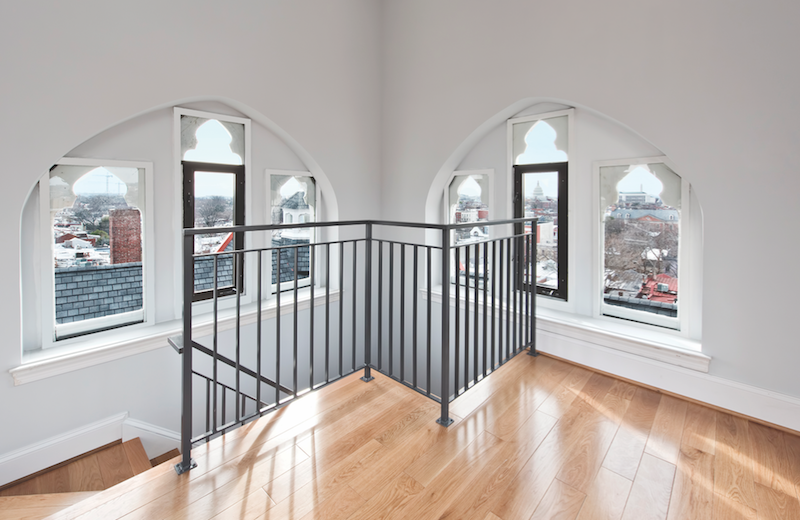 The view from the bell tower (which never had bells)—“now the highest privately owned view in D. C.,” according to developer Andrew T. Rubin.
The view from the bell tower (which never had bells)—“now the highest privately owned view in D. C.,” according to developer Andrew T. Rubin.
That position clashed with Bonstra and Rubin’s desire to make the building more appealing to prospective buyers by replacing translucent lites at eye level with transparent ones in some windows. “Stained glass might be good for spirituality,” Bonstra says, “but when you live in a building, you want to be able to look out the windows.”
The Review Board had denied two previous requests from developers who wanted to replace ornamental glass with clear glass; both decisions were upheld on appeal to the next higher authority. But they gave the Sanctuary team a chance to make the case for switching out the glass.
After conducting an extensive search, Bonstra and Rubin identified the glass restoration expert they believed could help them—Cumberland Stained Glass, Mechanicsburg, Pa. The 25-year-old studio is accredited by the Stained Glass Association of America.
The design team organized a site visit with Pfaehler and representatives from the D. C. Historic Preservation Office, the Capitol Hill Restoration Society, and the Advisory Neighborhood Commission. Cumberland’s President, Bryan Lerew, demonstrated a mocked-up window that illustrated how the lead matrix and ornamental design could be preserved, even if some lites were replaced with specialty transparent glass.
It was a textbook case of the effectiveness of physical mockups in building design. “The mockup did influence us,” says Pfaehler. “It allowed us to see the actual glazing in the appropriate lighting.” Lerew had specified a German-made glass (“Restover”) with a kind of distressed exterior side for the clear lites. The mockup helped overcome Pfaehler’s concerns about the sheen and reflectance of the clear glass as viewed from the street; at the same time, the glass provided the see-through visibility Bonstra and Rubin were looking for.
But the Review Board was not done. “We examined each window in detail to determine how much glass could be replaced without compromising the overall artistry of the window,” says Pfaehler. When Bonstra asked permission to punch holes in a street-facing wall for new windows, the board issued a categorical no. But they did allow new windows on the rear of the church and some operable windows for ventilation.
Following months of negotiation, the Review Board approved the revisions to the windows, although Pfaehler was emphatic that the decision applied only to the Sanctuary and was not to viewed as precedent setting.
Refurbishing the 132 windows took six of Cumberland’s technicians nine months, Lerew says. “The windows were badly out of repair, and the lead had outlived its life,” he says. Cumberland craftsmen painstakingly preserved 75% of the original glass and restored all the original designs. The total cost of the glasswork, according to Rubin: about 10% of the total $15.1 million construction cost.
SHORING UP THE STRUCTURE
The 85-foot-tall bell tower needed major structural reinforcement. “We removed about four feet of the original wall all the way to the basement, then poured a 28-by-42-inch concrete column and laid engineered structural beams,” says Brian Lucey, Potomac Construction Group’s Vice President of Operations.
Inserting the shaft for the new three-story KONE elevator between the church and the old classroom annex proved vexing for Potomac and structural engineer Structura. Concrete in the annex had to be demolished, underpinning placed around the foundations, and new footings laid. “We had to shore up each concrete floor as we moved up, putting in new cinder block shaft walls to the roof,” says Lucey.
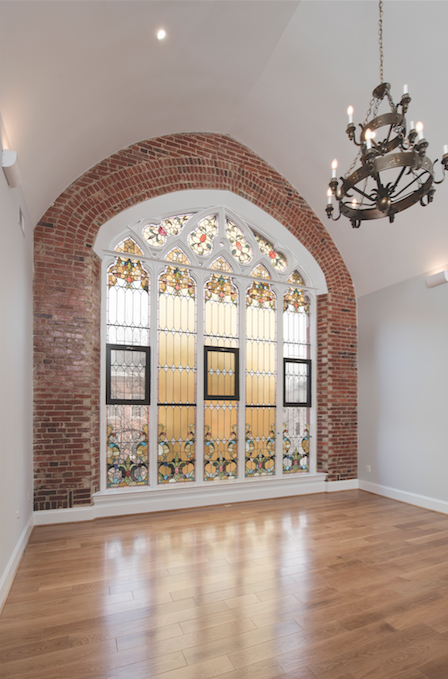 Potomac Construction Group crews carefully preserved light fixtures and original brick throughout the nearly 35,000-sf restoration. Note the special German-made transparent glass and the operable windows, two features the developer and design team worked hard to convince the District of Columbia Historic Preservation Review Board to approve.
Potomac Construction Group crews carefully preserved light fixtures and original brick throughout the nearly 35,000-sf restoration. Note the special German-made transparent glass and the operable windows, two features the developer and design team worked hard to convince the District of Columbia Historic Preservation Review Board to approve.
“The window lines throughout the building varied due to the differences in structure and purpose of the church and annex,” says Colin Drumright, Project Architect, Bonstra | Haresign. “We incorporated these differences into the living units by having double-height spaces and varied floor elevations on the third floor.” Sloped seating in the choir loft was demolished to gain the proper alignment, he notes.
Potomac finished the 34,693-sf job last New Year’s Eve. By September, the 29 one- and two-bedroom units (440 to 1,900 sf) were sold out. The penthouse (two bedrooms/2.5 baths) went for $1,525,000, a condo sales figure the city’s Northeast quadrant had not seen since 2008.
The Sanctuary received an Award of Excellence in Historic Architecture from AIA Northern Virginia. Next month, it will be announced as a winner in Building Design+Construction’s Reconstruction Awards.
The conversion of the church had an almost Damascene effect on the participants. “We felt more like stewards of the building than developers,” says Rubin. “The church started telling us what to do.”
PROJECT TEAM | THE SANCTUARY
CLIENT The Rubin Group, in partnership with Regua ARCHITECT Bonstra | Haresign Architects STRUCTURAL ENGINEER Structura CIVIL ENGINEER VIKA Capitol MECHANICAL ENGINEER Capitol Engineering Group GLASS CONSULTANT Cumberland Stained Glass GC Potomac Construction Group
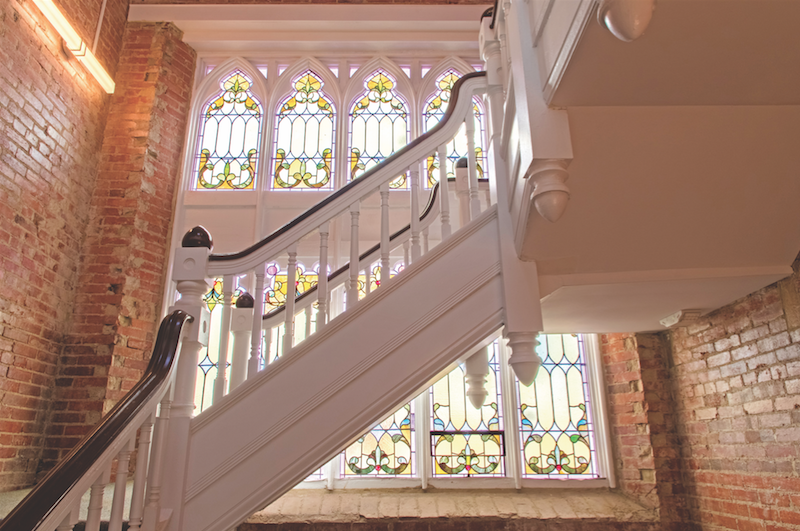 Plaster was removed from the walls in the main stairwell (and elsewhere) to reveal the original brick. The wooden balustrade was restored.
Plaster was removed from the walls in the main stairwell (and elsewhere) to reveal the original brick. The wooden balustrade was restored.
Related Stories
| Aug 11, 2010
Oldcastle Precast Building Systems wins PCI 2009 Sustainable Design Award
Oldcastle Precast Building Systems was part of the award winning team behind the affordable housing development Melrose Commons Site 5 situated in the South Bronx. PCI (Precast Concrete Institute) recently selected Melrose 5 for the “2009 PCI Design Award for Best Sustainable Project”.
| Aug 11, 2010
National Intrepid Center of Excellence tops out at Walter Reed
SmithGroup and The Intrepid Fallen Heroes Fund (IFHF), a non-profit organization supporting the men and women of the United States Armed Forces and their families, celebrated the overall structural completion of the National Intrepid Center of Excellence (NICoE), an advanced facility dedicated to research, diagnosis and treatment of military personnel and veterans suffering from traumatic brain injury.
| Aug 11, 2010
USGBC honors Brad Pitt's Make It Right New Orleans as the ‘largest and greenest single-family community in the world’
U.S. Green Building Council President, CEO and Founding Chair Rick Fedrizzi today declared that the neighborhood being built by Make It Right New Orleans, the post-Katrina housing initiative launched by actor Brad Pitt, is the “largest and greenest community of single-family homes in the world” at the annual Clinton Global Initiative meeting in New York.
| Aug 11, 2010
Trump luxury condos in Jersey City get more luxurious
Only two years after opening, Jersey City-based Trump Plaza Residences is getting a facelift. Interior designer Benjamin Noriega-Ortiz of BNOdesign has been commissioned to create a fresh design for the residential tower's entrance and outdoor pool, cabana, and lawn spaces. Renovations on the 55-story, 443-unit luxury high-rise will be completed in two phases.
| Aug 11, 2010
Apartments offer skyline view of Houston
Perched atop a hill near downtown Houston, the Gables Memorial Hills residential tower will rise to eight stories and cover 2.68 acres. With an average unit size of 965 sf, the brick and cast-stone complex will consist of 70% one-bedroom units and 30% two-bedroom units, some of which overlook downtown.
| Aug 11, 2010
Sustainable features central to independent-living building
Architecture firm Perkins Eastman, together with Saint Johns on the Lake retirement community, plans to open a 21-story, 88-unit independent-living building for seniors by mid 2011. When the $46-million project is complete, it will offer residents a streetside café, art gallery, spa and wellness center, classroom, and community performance space.
| Aug 11, 2010
Historic building to be restored in Kansas City
Construction has begun on the conversion of the historic 17-story Home Savings Association building in Kansas City, Mo. The transformed structure, to be known as Grand Boulevard Lofts, will house 134 apartment units. The $18-million project, designed by architect Rosemann & Associates, follows a revitalization of downtown Kansas City, where there is high demand for affordable housing to ser...
| Aug 11, 2010
Old factory converted from hearth to home
A former briquette factory in Cologne-Frechen, Germany, was converted into a mixed-use building by Astoc Architects & Planners, Cologne, in association with Rheinischen Amt für Denkmalpflege—the Rhenish agency for historic preservation. The roughly 172,200-sf building includes a mix of residential condominiums, lofts, and leased commercial space.
| Aug 11, 2010
And the world's tallest building is…
At more than 2,600 feet high, the Burj Dubai (right) can still lay claim to the title of world's tallest building—although like all other super-tall buildings, its exact height will have to be recalculated now that the Council on Tall Buildings and Urban Habitat (CTBUH) announced a change to its height criteria.
| Aug 11, 2010
Luxury high-rise meets major milestone
A topping off ceremony was held in late October for 400 Fifth Avenue, a 57,000-sf high-rise that includes a 214-room luxury hotel and 190 high-end residential condominiums. Developed by Bizzi & Partners Development and designed by Gwathmey Siegel & Associates Architects, the 60-story tower in midtown Manhattan sits atop a smaller-scale 10-story base, which creates a street façade t...


